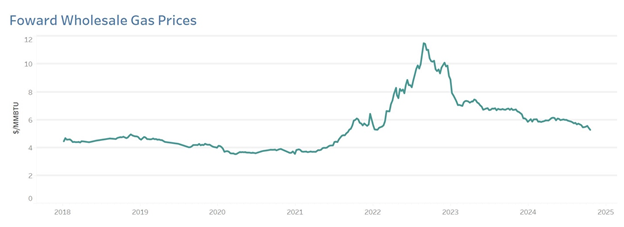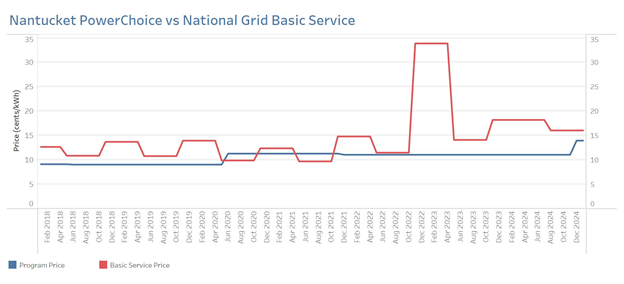Why did Nantucket PowerChoice prices increase in November 2024? Weren't natural gas prices lower than in the past?
Nantucket PowerChoice prices increased because electricity prices were higher at that time for all of New England than they were in the past.
Specifically, Nantucket previously signed an electricity supply contract for Nantucket PowerChoice in 2021, when electricity prices were much lower than in November 2024. After 2021, electricity prices increased sharply as a result of the war in Ukraine, then they came back down some, but in fall 2024, they remained elevated compared to where they were in 2021.
Natural gas prices drive electricity prices in New England because most of our electricity is generated by burning natural gas. The media reported that the wholesale price of natural gas had dropped back to pre-war levels, so it would seem to make sense that electricity prices had also dropped back to pre-war levels. But they had not, as the chart below shows.

The reason electricity prices have not returned to 2021 levels is that there is more than one wholesale price for natural gas:
- The price that dropped to pre-war levels is the “spot” price, which is a price for gas delivered currently.
- However, because the Nantucket PowerChoice contract is for electricity to be delivered over the next two years, the relevant natural gas price is the price for natural gas to be delivered over that time, which is a “forward” price.
As the chart below shows, forward natural gas prices have followed a similar trend as electricity prices: They have come down from their peak, but not to pre-Ukraine-war levels.

A good benchmark for Nantucket PowerChoice prices is National Grid’s Basic Service price. The Basic Service price shows a similar trend: The chart below shows that prices shot up in late 2022 with the Ukraine war, and while prices have come down since, they have not returned to pre-Ukraine-war levels.

Importantly, even with the November 2024 increase, the price of Nantucket PowerChoice remains below National Grid’s Basic Service price, and on average, Nantucket’s price has been more than 25% lower than National Grid’s Basic Service price since program launch.





